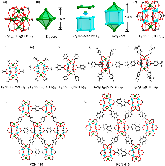[Ti 8 Zr 2 O 12 (COO) 16 ] Cluster: An Ideal Inorganic Building Unit for Photoactive Metal–Organic Frameworks
- Department of Chemistry, Texas A&,M University, College Station, Texas 77843-3255, United States
- Hefei National Laboratory for Physical Sciences at the Microscale, Collaborative Innovation Center of Suzhou Nano Science and Technology, Department of Chemistry, University of Science and Technology of China, Hefei 230026, P. R. China
- Berzelii Centre EXSELENT on Porous Materials and Inorganic and Structural Chemistry, Department of Materials and Environmental Chemistry, Stockholm University, Stockholm 106 91, Sweden
- School of Physics and Optoelectronics, Xiangtan University, Xiangtan 411105, P. R. China
- Department of Chemistry, Texas A&,M University, College Station, Texas 77843-3255, United States, Department of Materials Science and Engineering, Texas A&,M University, College Station, Texas 77843-3003, United States
Metal–organic frameworks (MOFs) based on Ti-oxo clusters (Ti-MOFs) represent a naturally self-assembled superlattice of TiO2 nanoparticles separated by designable organic linkers as antenna chromophores, epitomizing a promising platform for solar energy conversion. However, despite the vast, diverse, and well-developed Ti-cluster chemistry, only a scarce number of Ti-MOFs have been documented. The synthetic conditions of most Ti-based clusters are incompatible with those required for MOF crystallization, which has severely limited the development of Ti-MOFs. This challenge has been met herein by the discovery of the [Ti8Zr2O12(COO)16] cluster as a nearly ideal building unit for photoactive MOFs. A family of isoreticular photoactive MOFs were assembled, and their orbital alignments were fine-tuned by rational functionalization of organic linkers under computational guidance. These MOFs demonstrate high porosity, excellent chemical stability, tunable photoresponse, and good activity toward photocatalytic hydrogen evolution reactions. The discovery of the [Ti8Zr2O12(COO)16] cluster and the facile construction of photoactive MOFs from this cluster shall pave the way for the development of future Ti-MOF-based photocatalysts.
- Research Organization:
- Energy Frontier Research Centers (EFRC) (United States). Center for Gas Separations Relevant to Clean Energy Technologies (CGS); Texas A & M Univ., College Station, TX (United States)
- Sponsoring Organization:
- USDOE Office of Science (SC), Basic Energy Sciences (BES); USDOE Office of Fossil Energy (FE)
- Grant/Contract Number:
- SC0001015; FE0026472; AC02-06CH11357
- OSTI ID:
- 1410591
- Alternate ID(s):
- OSTI ID: 1470113; OSTI ID: 1508267
- Journal Information:
- ACS Central Science, Journal Name: ACS Central Science Vol. 4 Journal Issue: 1; ISSN 2374-7943
- Publisher:
- American Chemical Society (ACS)Copyright Statement
- Country of Publication:
- United States
- Language:
- English
Web of Science
Similar Records
Photosensitizer‐Anchored 2D MOF Nanosheets as Highly Stable and Accessible Catalysts toward Artemisinin Production
A Titanium–Organic Framework as an Exemplar of Combining the Chemistry of Metal– and Covalent–Organic Frameworks




